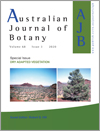
Australian Journal of Botany
Volume 68 Number 3 2020
Dry Adapted Vegetation
BT19110New species of xeromorphic Banksia (Proteaceae) foliage and Banksia-like pollen from the late Eocene of Western Australia

Banksia is an iconic Australian genus with a strong fossil record that illuminates its long evolutionary history. Tiny, tightly-rolled Banksia leaves that have close resemblance to those of numerous modern species of seasonally hot, dry habitats were present in the Eocene of Western Australia at least 34 million years ago. This is a remarkable discovery given that Eocene climates were much wetter than now, and suggests that classic transpiration-limiting leaf types evolved within swampy habitats that likely experienced periodic water stress.
BT19126Fossil evidence for the evolution of the Casuarinaceae in response to low soil nutrients and a drying climate in Cenozoic Australia
 , Sung Soo Whang, Vera Korasidis, Bradley Bianco, Kathryn E. Hill, Rosemary Paull and Gregory R. Guerin
, Sung Soo Whang, Vera Korasidis, Bradley Bianco, Kathryn E. Hill, Rosemary Paull and Gregory R. Guerin

The fossil record and morphology of the living species of the Southern Hemisphere family Casuarinaceae are reviewed and it is concluded that the extant genus Gymnostoma is the closest to the ancestral form and is a result of a scleromorphic response. The other genera probably evolved later in response to drying conditions from the mid-Cenozoic onwards. We conclude that the morphology of the living and fossil vegetative branchlets provides evidence that low soil nutrients (especially phosphorus), high water availability in a light limited (shady) environment and reducing water availability (xeromorphy) were the major drivers of evolution in this unique plant family.

Phylogenetic and phylogeographic analysis provides a basis for understanding the origins and evolutionary history of the xeromorphic component of the Australian vegetation. Phylogenetic evidence shows the history of the evolution of sclerophyll and xeromorphic vegetation types from rainforest ancestors, including single origin xeromorphic radiations as well as multiple origins. Phylogeographic evidence shows persistence of species through the Pleistocene with accumulation of genetic diversity and differentiation. This review highlights the complexities and nuances in different lineages and the multiple responses of the flora to aridification.

Lake George near Canberra is unique in Australia. It was created by tectonic uplift of the Lake George Range, and now preserves a 3–4-million-year microfossil history of plants growing on the Southern Tablelands. These microfossils demonstrate that rainforest species now found only in Tasmania, New Zealand, Papua New Guinea and New Caledonia grew around the shoreline and on the Range 2–3 million years ago before being replaced by dry forests and grasslands as climates across Australia became increasingly cool and arid.

A review of Australia’s inland arid region shows that biogeographers have not resolved the issue of defining its barriers 130 years after they were first described.
BT19077 Abstract | BT19077 Full Text | BT19077PDF (4 MB) Open Access Article

The morpho-anatomical structure in selected Australian xerophytes was investigated. The evolutionary origin of the sclerophyllous flora now characteristic of Australian vegetation from seasonally arid climates may have evolved during mesic times in the past and only minor modifications were needed to adjust to the gradually drying climate up to the present time.



